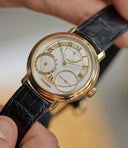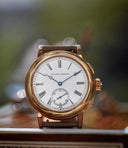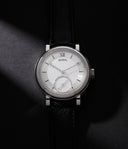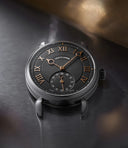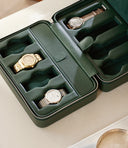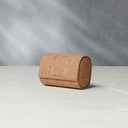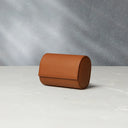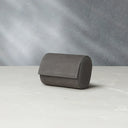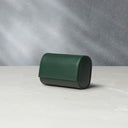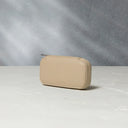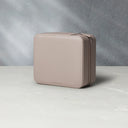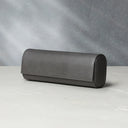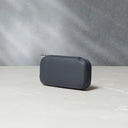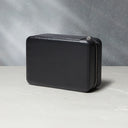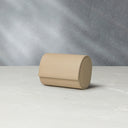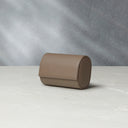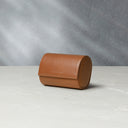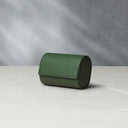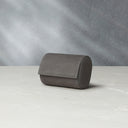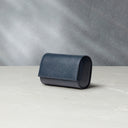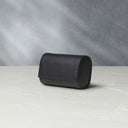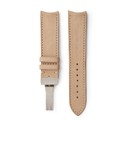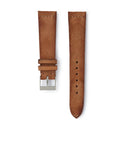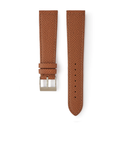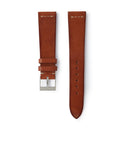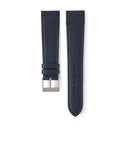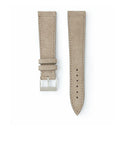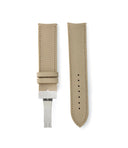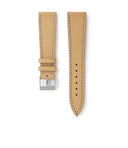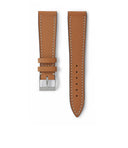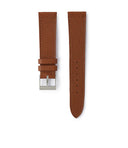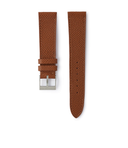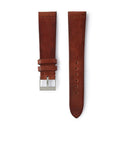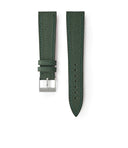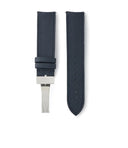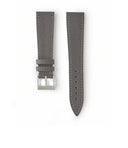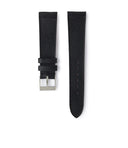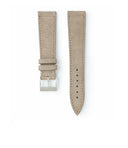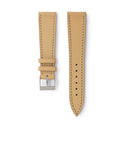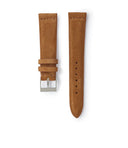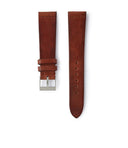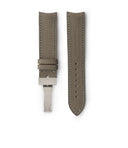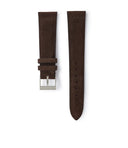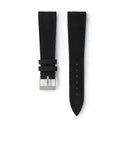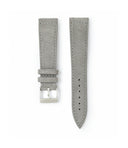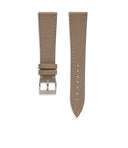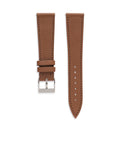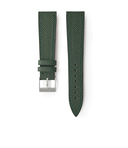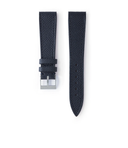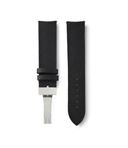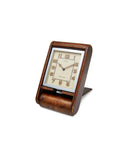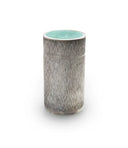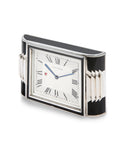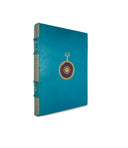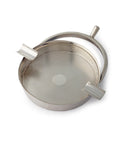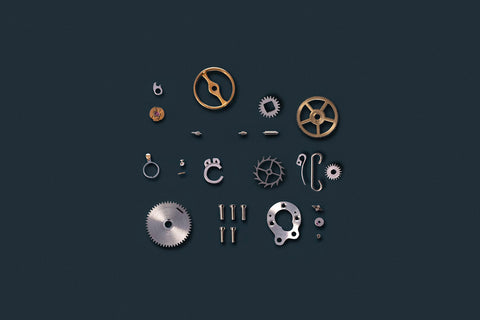Vianney Halter announced his independent brand to the world during Baselworld in 1998. The watch he chose for the occasion was the Antiqua. It was the first from his Futur Antérieur collection that imagined a future seen through the vision of the likes of Jules Verne and H. G. Wells. The Antiqua encapsulates that era’s whimsy and wonder for a future that would never come to pass.
Underpinning the irregular shape of the watch face is a perfectly traditional 36mm round base. Also traditional is the complication it houses – a perpetual calendar. The innovative design of the Antiqua was created by Halter in collaboration with Jeff Barnes, an American graphic designer, with a longstanding interest in horology. It is understood that Barnes had envisioned a wristwatch with four different sub-dials, which married steampunk influences with the marine chronometre-style layout Halter favoured.
This particular example, forged from white gold with yellow registers, is a rare configuration found early in the series. Halter stopped creating the Antiqua in 2016. In those 18 years, fewer than 100 examples of the watch are understood to have been created.
Even within this exceedingly limited series, this particular piece stands apart. It was one of the first few examples Halter crafted extensively by hand in his Janvier SA workshop in Sainte-Croix, Switzerland. It bears details such as the earliest iteration of his initials, seen in the time display sector. According to the watchmaker, fewer than 10 of the earliest series Antiquas wear this brand mark for the simple reason that at the time Halter had not firmed up his logo.
Over the last few months, Halter has had the opportunity to reacquaint himself with this piece, extensively servicing and upgrading parts. The extensive list of interventions includes – but is not limited to – a new date jumping spring, jumping wheel assembly as well as a fresh date wheel. The result is a more precise transition from one day to the next. The new date jumping wheel assembly required a near wholesale reshaping of surrounding bridges. Halter has created open work hours and minutes wheels, where there were solid disks before and also modified the month corrector mechanism.
The improvements also extend to the case. Halter has drilled new holes for additional rivets to better secure the porthole-style layout of the displays. All screws have been replaced while seals have been reinforced. The result is a rare instance an early Antiqua built to contemporary tolerances.
Each unit of time is separated, it’s footprint commensurate with how often it would be consulted during normal wear. They are framed by windows that are designed to bring to mind riveted portholes on the sides of ships or submarines.
The one expressing the hours and minutes is visually dominant in its scale, followed by the display that indicates the month; this window also incorporates the leap year indicator. This is followed by date indicator while the smallest aperture shows off the digital date. Viewed in profile, these registers reveal their heights to be in the same order of priority as their overall diameter. Both the numerals and text on the dials are filled with indelible black enamel. The hands are all heat blued. Noteworthy is the simple ‘VH’ branding, which marks this as one of the earliest examples of the reference.
Like on the registers, four dolg rivets appear in the rest of the non-functional spaces on the dial side. The white gold case is comprised of 30 different component types (making up almost 100 pieces in total), with no fewer than 104 gold rivets throughout. Together with the gold registers – rarely paired with white metal Antiquas – the detail gives the watch a warm glow.
The porthole motif continues to the crown. This is used to set the time and quickset the date. On the left hand side, on the flank of the case are two correctors to manipulate the calendar complication. The concealed lugs are 20mm apart and come furnished with a black, wide-grained leather strap secured by white gold signed pin buckle. The lugs also have gold rivets details on the outside.
As is to be expected, this Antiqua features the upgraded self-winding calibre VH198. While based on the Lemania 8810, it was extensively redesigned by Halter on launch and the watchmaker has continued to improve on it over the years. This example accrues the benefits of the watchmaker’s work over the last two decades.
Although the VH198 shares many of the same impressive mechanical elements as the Cal. 8810 (balance-wheel, anchor, escape-wheel and gear wheels), the unique bridges and baseplate are designed by Halter. Visible though the sapphire display back, the VH198 calibre is fitted with a patented ‘mysterious mass’ winding rotor. Using this system, the oscillating mass is hidden behind a peripheral ring, with no apparent link to the central rotor. This allows for an uninterrupted view of the beautifully finished movement. The mainplate is adorned with Geneva striping with the simple VH and brand mark and serial number etched by hand. This is a detail found exclusively in the earliest examples. The visual motif of the rivets continues here as well. The self-winding VH198 calibre oscillates at a frequency of 28,800 A/h, with a power-reserve of 35 hours. Running around the display caseback is a satinated rim with details such as the reference number and country of origin.
Accompanying the watch is the original wooden winding box, which displays the watch through its own riveted porthole. Even this was created by hand by Halter in his workshop.
The watch was originally retailed by famed erstwhile Antwerp-based Ginotti and features original paperwork marked as such. This single serial number white gold Antiqua with yellow gold registers marks an early moment in Halter’s journey as an independent brand. That it has recently been caringly preserved and made future-proof by the watchmaker himself makes it all the more special.
































































































